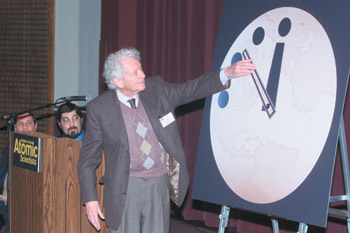 Time
for a change
Time
for a change
Let
the world be on notice: the clock is ticking." These were
the ominous words of George A. Lopez, chair of the board of directors
for the Bulletin of Atomic Scientists-based at the University
of Chicago-after announcing on February 27 that the minute hand
of the "Doomsday Clock" would be moved forward to seven
minutes before midnight.

The
clock is not a working timepiece, rather a mock-up of a clock
face representing the urgency of the global nuclear situation.
The closer the clock is to midnight, the more immediate the
threat of nuclear catastrophe.
Constructed
in 1947 and set at seven minutes to midnight, it has been reset
17 times since, each shift reflecting a change in the world's
political and military climate. The closest it has come to midnight
was two minutes in 1953, after the U.S. and the Soviet Union
developed the first hydrogen bombs. The safest setting was 17
minutes in 1991 when the same two nations signed the Strategic
Arms Reduction Treaty.
Since
1991 the clock has moved forward three times-to 14 minutes,
then nine minutes, and now seven. The latest change, according
to Lopez, was influenced by several geopolitical factors, including
the U.S. decision to walk away from the Antiballistic Missile
Treaty in June and its lack of participation in the Comprehensive
Test Ban Treaty.
Although
the events of September 11 played a small role in the decision
to advance the minute hand, "the clock has never moved
in response to a singular event," said Lopez, "no
matter how terrible." A chronicle of the clock's changes
from 1947 to the present can be seen at the Bulletin's
Web site, www.thebulletin.org.
-C.S.

![]()
 Time
for a change
Time
for a change